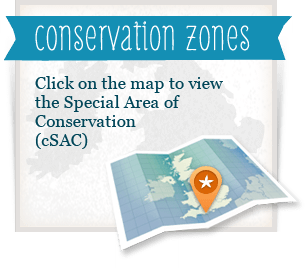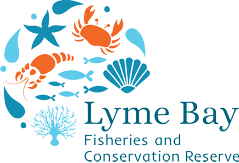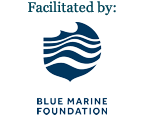
Overview of Marine Life
 The Lyme Bay reefs and the associated flora and fauna are considered to be nationally important conservation features. The reefs and adjacent areas are traditional fishing grounds for local fishing communities for which fishing is both culturally and economically important. Below is a small selection of some of the marine life found in Lyme Bay. You can also discover more on the Reef Species, Commercial Species and watch amazing Underwater Videos of marine life in action.
The Lyme Bay reefs and the associated flora and fauna are considered to be nationally important conservation features. The reefs and adjacent areas are traditional fishing grounds for local fishing communities for which fishing is both culturally and economically important. Below is a small selection of some of the marine life found in Lyme Bay. You can also discover more on the Reef Species, Commercial Species and watch amazing Underwater Videos of marine life in action.
![]()
Squat Lobster
'Galathea strigosa' have arms that can grow to be several times the length of their body and can be found up to 100m deep. Despite its name the squat lobster is not a true lobster at all but a member of a separate family which makes them closer to species of small crabs than lobsters.
'Galathea strigosa' have arms that can grow to be several times the length of their body and can be found up to 100m deep. Despite its name the squat lobster is not a true lobster at all but a member of a separate family which makes them closer to species of small crabs than lobsters.

Tompot Blenny
'Parablennius gattorugine' are very inquisitive fish that can grow up to 30cm long. They are common in shallow rocky seabeds around Britain and Northwest Europe and are strongly territorial. They will often even emerge to 'chase off' their own reflection in camera glass or in diver’s masks. They feed on small crustaceans, sea anenomes and prawns.
'Parablennius gattorugine' are very inquisitive fish that can grow up to 30cm long. They are common in shallow rocky seabeds around Britain and Northwest Europe and are strongly territorial. They will often even emerge to 'chase off' their own reflection in camera glass or in diver’s masks. They feed on small crustaceans, sea anenomes and prawns.

Cuttlefish Eggs
Common or European cuttlefish eggs grow attached to seagrass, Zostera marina, blades or rocks. Cuttlefish arrive in shallow bays and estuaries in spring to lay their eggs in seagrass beds. Cuttlefish eggs are often called sea-grapes because they are laid in bunches and look very much like a bunch of black grapes.
Common or European cuttlefish eggs grow attached to seagrass, Zostera marina, blades or rocks. Cuttlefish arrive in shallow bays and estuaries in spring to lay their eggs in seagrass beds. Cuttlefish eggs are often called sea-grapes because they are laid in bunches and look very much like a bunch of black grapes.

Light Bulb Sea Squirt
‘Clavelina lepadiformis' grows attached to the underside of rocky ledges. However, before settling down, they start life as a tadpole-like larvae. Once they find a spot to settle, they start by digesting their own brain, tail and spine-like structure called a notochord and then turn into adults. They are filter feeders and so suck in water and filter out the microscopic food particles carried along in the currents.
‘Clavelina lepadiformis' grows attached to the underside of rocky ledges. However, before settling down, they start life as a tadpole-like larvae. Once they find a spot to settle, they start by digesting their own brain, tail and spine-like structure called a notochord and then turn into adults. They are filter feeders and so suck in water and filter out the microscopic food particles carried along in the currents.

Starfish
‘Asterias rubens' belong to a larger group called ‘echinoderms’ which means ‘spiny-skinned’. This group includes other spiny species like sea urchins, sea cucumbers and brittle stars. Starfish eat shellfish such as cockles and mussels and use their strong arms to break open the shells. If the common starfish loses an arm, it can regrow it and some starfish shed their arms to escape predators, or if the arm is damaged.
‘Asterias rubens' belong to a larger group called ‘echinoderms’ which means ‘spiny-skinned’. This group includes other spiny species like sea urchins, sea cucumbers and brittle stars. Starfish eat shellfish such as cockles and mussels and use their strong arms to break open the shells. If the common starfish loses an arm, it can regrow it and some starfish shed their arms to escape predators, or if the arm is damaged.

Wrasse
‘Labridae’ is the name of the wrasse family and it contains over 600 species worldwide. Wrasse are cleaner fish and eat parasites like sea lice from other fish. The most common species of wrasse found in the UK are cuckoo wrasse, corkwing wrasse and ballan wrasse. Ballan wrasse are the largest of the three and can grow up to 60cm long.
‘Labridae’ is the name of the wrasse family and it contains over 600 species worldwide. Wrasse are cleaner fish and eat parasites like sea lice from other fish. The most common species of wrasse found in the UK are cuckoo wrasse, corkwing wrasse and ballan wrasse. Ballan wrasse are the largest of the three and can grow up to 60cm long.

Harbour Porpoise
‘Phocoena phocoena’ used to be referred to as the ‘puffing pig' because of the sneeze-like puffing sound it makes when it comes up to the surface to breathe. It is one of the smallest mammals in the sea but can still dive to up to 224m in one breath. As the name would suggest, the harbour porpoise is often found in the temperate waters near bays, estuaries, harbours, rivers and tidal channels.
‘Phocoena phocoena’ used to be referred to as the ‘puffing pig' because of the sneeze-like puffing sound it makes when it comes up to the surface to breathe. It is one of the smallest mammals in the sea but can still dive to up to 224m in one breath. As the name would suggest, the harbour porpoise is often found in the temperate waters near bays, estuaries, harbours, rivers and tidal channels.

Bottlenose Dolphin
‘Tursiops truncatus’ are very acrobatic and can jump up to five meters out of the water before crashing back down into the sea. There are various theories on why they do this such as to clean parasites off their bodies, communicate with other pods or just to have fun. A bottlenose dolphin will have its own signature whistle, and this is so distinct that scientists are able to identify individuals by the shape the whistle produces on a sonogram. A bottlenose may have developed its signature whistle by the time it is only one month old.
‘Tursiops truncatus’ are very acrobatic and can jump up to five meters out of the water before crashing back down into the sea. There are various theories on why they do this such as to clean parasites off their bodies, communicate with other pods or just to have fun. A bottlenose dolphin will have its own signature whistle, and this is so distinct that scientists are able to identify individuals by the shape the whistle produces on a sonogram. A bottlenose may have developed its signature whistle by the time it is only one month old.

White-beaked Dolphin
‘Lagenorhynchus albirostris’ are very social, not only with members of their own species but with orca, humpback, minke, and fin whales, with whom they sometimes group feed. White-beaked dolphins have even been spotted harassing whales to make them swim faster in order to create a wake for the dolphins to swim in. An all-female pod of white-beaked dolphins is called a ‘party’ and an all-male pod is called an ‘alliance’.
‘Lagenorhynchus albirostris’ are very social, not only with members of their own species but with orca, humpback, minke, and fin whales, with whom they sometimes group feed. White-beaked dolphins have even been spotted harassing whales to make them swim faster in order to create a wake for the dolphins to swim in. An all-female pod of white-beaked dolphins is called a ‘party’ and an all-male pod is called an ‘alliance’.

Common Dolphin
‘Delphinus delphis’ can swim amazingly fast, reaching speeds of up to 65kph and their groups can reach over 10,000 individuals. Their maximum dive times can reach 8 minutes, but they usually dive for about 2 minutes. Dolphins communicate with each other through a complicate series of clicks and whistles and also use these to help them hunt. This is called echolocation and allows the dolphins to ‘see’ by interpreting the sound waves that bounce back off objects in the water.
‘Delphinus delphis’ can swim amazingly fast, reaching speeds of up to 65kph and their groups can reach over 10,000 individuals. Their maximum dive times can reach 8 minutes, but they usually dive for about 2 minutes. Dolphins communicate with each other through a complicate series of clicks and whistles and also use these to help them hunt. This is called echolocation and allows the dolphins to ‘see’ by interpreting the sound waves that bounce back off objects in the water.

Ocean Sunfish
‘Mola mola’ is the heaviest bony fish in the world (ie excluding sharks) and the heaviest ever recorded weighed over 2,000kg which is heavier than a car. Historically they were very valuable and used to be accepted as a form of tax payment in Japan in the 16th and 17th centuries. They also release more eggs than any other vertebrate and females can release up to 300 million at once. Sunfish are called sunfish because they can spend up to half a day basking at the surface to warm up their bodies after they’ve dived down into cold waters 600m deep.
‘Mola mola’ is the heaviest bony fish in the world (ie excluding sharks) and the heaviest ever recorded weighed over 2,000kg which is heavier than a car. Historically they were very valuable and used to be accepted as a form of tax payment in Japan in the 16th and 17th centuries. They also release more eggs than any other vertebrate and females can release up to 300 million at once. Sunfish are called sunfish because they can spend up to half a day basking at the surface to warm up their bodies after they’ve dived down into cold waters 600m deep.

Manx Shearwater
‘Puffinus puffinus’ are very talented fliers and often fly so low that their wingtips skim the surface of the water. This is very important because Manx Shearwaters migrate over 10,000 kilometres to South America in the winter. One particular shearwater was tracked in 1957 and it was calculated to have flown over 8 million during its life.
‘Puffinus puffinus’ are very talented fliers and often fly so low that their wingtips skim the surface of the water. This is very important because Manx Shearwaters migrate over 10,000 kilometres to South America in the winter. One particular shearwater was tracked in 1957 and it was calculated to have flown over 8 million during its life.

Risso’s Dolphin
‘Grampus griseus’ have a very unique physical appearance and the numerous white marks on their bodies are scars. These can be from squid (their favourite prey) or from other Risso's dolphins. These dolphins are unusual in that they don’t have any teeth in their upper jaw and only have 4-14 in their lower jaw, so tend to swallow squid whole.
‘Grampus griseus’ have a very unique physical appearance and the numerous white marks on their bodies are scars. These can be from squid (their favourite prey) or from other Risso's dolphins. These dolphins are unusual in that they don’t have any teeth in their upper jaw and only have 4-14 in their lower jaw, so tend to swallow squid whole.

Octopus (assuming it’s the common octopus)
‘Octopus vulgaris’ have eight arms and each arm has two rows of suckers with receptors in them that allow the octopus to taste whatever it is touching. Octopus can also change colour by contracting pigment cells in their skin and can adapt the texture of their skin, so they are perfectly camouflaged. This helps them to both sneak up on prey and evade predation.
‘Octopus vulgaris’ have eight arms and each arm has two rows of suckers with receptors in them that allow the octopus to taste whatever it is touching. Octopus can also change colour by contracting pigment cells in their skin and can adapt the texture of their skin, so they are perfectly camouflaged. This helps them to both sneak up on prey and evade predation.

Dogfish
‘Squalus acanthias’ are cartilaginous so do not have bones but are instead made of cartilage. Sharks that are grouped into the dogfish family are named so because fishermen have observed them chasing down smaller fish in dog-like packs. To defend themselves, dogfish may inject venom into predators from the two spines near their dorsal fins. This makes dogfish one of the very few sharks to use venom as opposed to using sharp teeth as a defence.
‘Squalus acanthias’ are cartilaginous so do not have bones but are instead made of cartilage. Sharks that are grouped into the dogfish family are named so because fishermen have observed them chasing down smaller fish in dog-like packs. To defend themselves, dogfish may inject venom into predators from the two spines near their dorsal fins. This makes dogfish one of the very few sharks to use venom as opposed to using sharp teeth as a defence.

Tope
‘Galeorhinus galeus’ are also referred to as the school shark, soupfin shark, and snapper shark. They are ovoviviparous, so the eggs stay inside the mother and the babies are born when they are well developed. There is no placenta and the embryo feeds on the nutrients from its own egg yolk. There can be up to 52 pups born in a litter.
‘Galeorhinus galeus’ are also referred to as the school shark, soupfin shark, and snapper shark. They are ovoviviparous, so the eggs stay inside the mother and the babies are born when they are well developed. There is no placenta and the embryo feeds on the nutrients from its own egg yolk. There can be up to 52 pups born in a litter.

Smooth hound
‘Mustelus mustelus’ scour the seabed for crustaceans such as crabs, lobsters and hermit crabs, but will also eat shellfish. Rather than having the typical sharp teeth associated with sharks the smooth-hound has blunt but powerful plates which are adapted perfectly to crush the crustaceans that make up the majority of its diet. This apparent lack of teeth has led to smoot hounds also being known as gummy sharks.
‘Mustelus mustelus’ scour the seabed for crustaceans such as crabs, lobsters and hermit crabs, but will also eat shellfish. Rather than having the typical sharp teeth associated with sharks the smooth-hound has blunt but powerful plates which are adapted perfectly to crush the crustaceans that make up the majority of its diet. This apparent lack of teeth has led to smoot hounds also being known as gummy sharks.
![]()





















